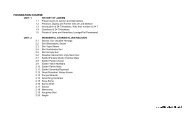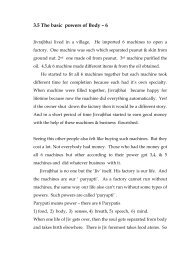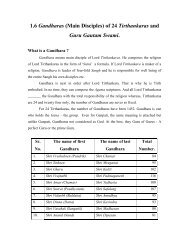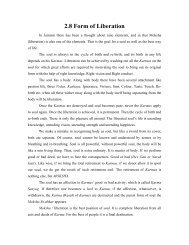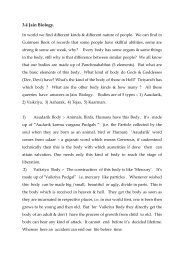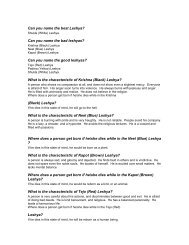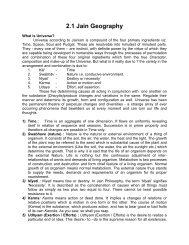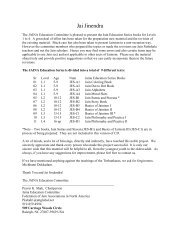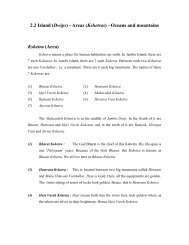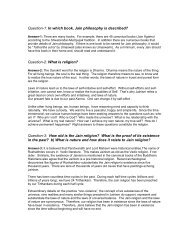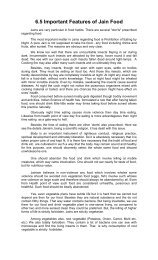Paryushan Parva - Jainism, Jain Religion - colleges
Paryushan Parva - Jainism, Jain Religion - colleges
Paryushan Parva - Jainism, Jain Religion - colleges
Create successful ePaper yourself
Turn your PDF publications into a flip-book with our unique Google optimized e-Paper software.
Sämäyik in English with Meaning<br />
State of Equanimity<br />
Kevali Pannatum Dhammun Saranam<br />
Pavvajjämi.<br />
Original Sutra<br />
Khämemi Savve Jiva,<br />
Savve Jiva Khamantu Me,<br />
Metti Me Savve Bhuyesu,<br />
Veram Majham Na Kenai.<br />
Meaning<br />
I grant forgiveness to all living beings,<br />
All living beings grant me forgiveness.<br />
My friendship is with all living beings,<br />
My enmity is totally nonexistent.<br />
Michchhä Mi Dukkadam<br />
Meaning of Some <strong>Jain</strong> Words<br />
Moksha = moha + kshaya; moha means delusion and kshaya means eradication - this makes Moksha as the state where<br />
there is no delusion and all karma are eradicated. There are three jewels, samyak-darsana or right perception<br />
(inclination or belief), samyak-jnäna or right knowledge (cognition), samyak-chäritra or right conduct - these three<br />
combined are the means of Moksha.<br />
Material world (the cycle of transmigration – samsära) involves cycles of birth, aging and death, and misery and no<br />
permanent happiness<br />
Karman particles (non-living, very subtle substance) are attracted to the soul because of false belief (Mithyättva),<br />
vowlessness (non-abstinence) (Avirati), negligence (Pramäda), passions (Kashäya) and Activities (Yogäs). These<br />
Karman particles that are attached to the soul are called karma. Karma is the hindrance (obstacle) that does not allow us<br />
to realize the true qualities of ätmä<br />
Svädhyäya is one of the six internal tapas and one of the six daily activities of the householder. Svädhyäya is consisted<br />
of five elements. (i) vächanä- reading of the <strong>Jain</strong> canonical books; (ii) pruchhanä- asking the guru questions about<br />
them; (iii) parivartanä- repetition of what was learned previously so one does not forget; (iv) anuprekshä- deep<br />
contemplation of what was learned (with the meaning); (v) dharma-kathä- inspiring others about <strong><strong>Jain</strong>ism</strong> and listening<br />
to the exposition of religious parables. Great Ächärya Amitgati says, one cannot get rid off the darkness of his/her<br />
ignorance without the brightness of svädhyäya. Another great Ächärya Vamadeva says, svädhyäya is one of the four<br />
anuyogas propounded by the Jina. Ächärya Asadhara recommends the construction of svädhyäya-shäläs (schools)<br />
where there is no frequent visits by <strong>Jain</strong> monks and scholars.<br />
The message of Jina, Lord Mahdvira the last Tirthankara, is carried by Ächäryas, our spiritual leaders. They have 36<br />
attributes, (see the meaning of Panchindiya Sutra, Lesson 2 of Sämäyik). The responsibility of the spiritual welfare of<br />
the entire <strong>Jain</strong> Sangh (community) rests on the shoulders of Ächäryas. Before reaching this state, one has to do an indepth<br />
study and have a thorough mastery of the <strong>Jain</strong> Ägams. In addition to acquiring a high level of spiritual excellence,<br />
they also have the ability to lead the monastic communion. They should also know the various languages of the country<br />
and have acquired a sound knowledge of other philosophies, ideologies, and religions of the region and the world.<br />
Svetämbar means white [cotton]-clad; name of <strong>Jain</strong> sect whose mendicants wear white garments. Digambar means skyclad;<br />
name of the <strong>Jain</strong> sect whose mendicants practice ascetic nudity.<br />
In Prakrut, it called Tapa. To cease to have desire is called Tapa. Tapa means hardship on one’s body, senses and mind,<br />
practiced to develop adequate spiritual abilities for reducing passions. Bodily activities are dominant in the external<br />
austerities, and mental activities are dominant in the internal austerities. There are twelve types - six external tapa: 1)<br />
Anasan - complete abstinence of eating and drinking, 2) Unodari or Alpähära - reduction in the quantity of food one<br />
normally eats, 3) Vrutti-Samkespa or Ichhänirodha - control of desire for food and material things, 4) Rasatyäga -<br />
complete abstinence of eating or drinking juicy and tasty foods such as honey, alcohol, butter, milk, tea, sweets, juice<br />
etc. (no attachments to the taste of the foods), 5) Käyäklesa – to train the body to be tolerant and 6) Samlinatä – control<br />
of the pleasures of five senses. Six internal tapa: 1) Präyaschita - repentance for the breach of vows 2) Vinaya -<br />
appropriate behavior towards a teacher 3) Vaiyävrata - selfless service to the suffering and deserving 4) Svädhyäya -<br />
studying/listening of religious scriptures 5) Dhyäna - religious meditation and 6) Utsarga (käyotasarga) - nonattachment<br />
to the body.<br />
20



